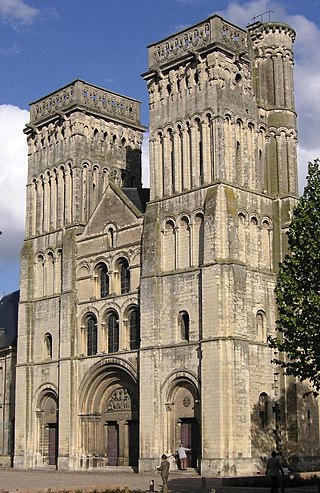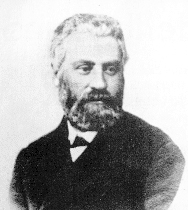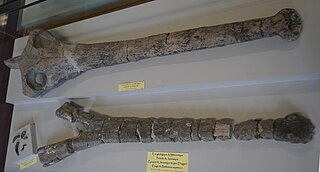
Caen is a commune 15 km (9.3 mi) inland from the northwestern coast of France. It is the prefecture of the department of Calvados. The city proper has 105,512 inhabitants, while its functional urban area has 470,000, making Caen the second largest urban area in Normandy and the 19th largest in France. It is also the third largest commune in all of Normandy after Le Havre and Rouen.

Megalosaurus is an extinct genus of large carnivorous theropod dinosaurs of the Middle Jurassic Epoch of southern England. Although fossils from other areas have been assigned to the genus, the only certain remains of Megalosaurus come from Oxfordshire and date to the late Middle Jurassic.

Poekilopleuron is a genus of carnosaurian theropod dinosaur, which lived during the middle Bathonian of the Jurassic, about 168 to 166 million years ago. The genus has been used under many different spelling variants, although only one, Poekilopleuron, is valid. The type species is P. bucklandii, named after William Buckland, and many junior synonyms of it have also been erected. Little material is currently known, as the holotype was destroyed in World War II, although many casts of the material still exist.

Teleidosaurus is an extinct genus of carnivorous metriorhynchoid crocodyliform from Middle Jurassic deposits of Normandy, France. The name Teleidosaurus means "Complete lizard", and is derived from the Greek Teleidos- ("complete") and σαῦρος -sauros ("lizard").
Teleosaurus is an extinct genus of teleosaurid crocodyliform found in the Middle Jurassic Calcaire de Caen Formation of France. It was approximately 3 metres (10 ft) in length. The holotype is MNHN AC 8746, a quarter of a skull and other associated postcranial remains, while other fragmentary specimens are known. The type species is T. cadomensis, but a second species, T. geoffroyi may also exist. It was previously considered a wastebasket taxon, with many other remains assigned to the genus.

Pelagosaurus is an extinct genus of thalattosuchian crocodyliform that lived during the Toarcian stage of the Lower Jurassic, around 183 Ma to 176 Ma, in shallow epicontinental seas that covered much of what is now Western Europe. The systematic taxonomy of Pelagosaurus has been fiercely disputed over the years, and was assigned to Thalattosuchia after its systematics within Teleosauridae were disputed. Pelagosaurus measured 2–3 m (6.6–9.8 ft) long.

Steneosaurus is a dubious genus of teleosaurid crocodyliform from the Middle or Late Jurassic of France. The genus has been used as a wastebasket taxon for thalattosuchian fossils for over two centuries, and almost all known historical species of teleosauroid have been included within it at one point. The genus has remained a wastebasket, with numerous species still included under the label ‘Steneosaurus’, many of which are unrelated to each other.
Paleontology or palaeontology is the study of prehistoric life forms on Earth through the examination of plant and animal fossils. This includes the study of body fossils, tracks (ichnites), burrows, cast-off parts, fossilised feces (coprolites), palynomorphs and chemical residues. Because humans have encountered fossils for millennia, paleontology has a long history both before and after becoming formalized as a science. This article records significant discoveries and events related to paleontology that occurred or were published in the year 1840.
Paleontology or palaeontology is the study of prehistoric life forms on Earth through the examination of plant and animal fossils. This includes the study of body fossils, tracks (ichnites), burrows, cast-off parts, fossilised feces (coprolites), palynomorphs and chemical residues. Because humans have encountered fossils for millennia, paleontology has a long history both before and after becoming formalized as a science. This article records significant discoveries and events related to paleontology that occurred or were published in the year 1830.

Arcisse de Caumont was a French historian and archaeologist.

Philippe-Charles or Philip Carel Schmerling was a Dutch/Belgian prehistorian, pioneer in paleontology, and geologist. He is often considered the founder of paleontology.
Jean-Pierre Sylvestre de Grateloup was a French physician and naturalist.

Eugène Eudes-Deslongchamps was a French paleontologist and naturalist born in Caen, the son of paleontologist Jacques Amand Eudes-Deslongchamps (1794–1867). He died at Château Matthieu, Calvados.

Bernard Renault was a French paleobotanist. He was a specialist in regard to the anatomy of Carboniferous and Permian plants.
Charles-Théophile Gaudin was a Swiss paleontologist known for his research in the field of paleobotany.

Thamnasteria is a genus of extinct stony corals.
Nicolas Robert Bouchard-Chantereaux was a French geologist and zoologist interested in malacology and marine biology. He was president de l'Administration du Muséum d'Histoire Naturelle Boulogne.
Edme Lesauvage, was a French naturalist and physician in Caen. He wrote numerous papers on medical subjects as well as on natural history. His main interest was in palaeontology and especially the fossils of Calcaires de Caen.

Seldsienean in an extinct genus of machimosaurid thalattosuchian from the Middle Jurassic of England and France. It is known from the Calcaire de Caen and the Cornbrash Formation.

Petrodactyle is an extinct genus of ctenochasmatid pterosaur from the Late Jurassic Mörnsheim Formation of Bavaria, Germany. The genus contains a single species, P. wellnhoferi, known from a partial skeleton belonging to a subadult individual. Petrodactyle is one of the largest Solnhofen pterosaurs and one of the largest Jurassic pterosaurs, with an estimated wingspan of 2.1 metres (6.9 ft).














